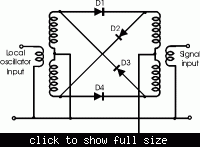obrien135
Full Member level 5

- Joined
- Nov 10, 2009
- Messages
- 240
- Helped
- 5
- Reputation
- 10
- Reaction score
- 5
- Trophy points
- 1,298
- Location
- Connecticut
- Activity points
- 3,259
Does it matter if the local oscillator amplitude on a mixer input (about 9Vpp) is greater than than the IF on the other mixer input (about 3Vpp)? It is a diode ring modulator.




